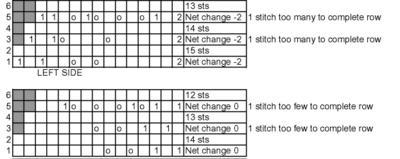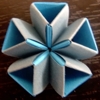"Please Explain"
OK all you smart knitters in readerland. In this post, unfortunately, I must reveal that I Do Not Know All and that I am Completely Stumped by the Ene's Scarf pattern from Scarf Style. I have stared at this chart for hours, I have searched endless websites, but I am still stumped.
Let me start by saying that I normally have no trouble with charts. I normally have no trouble with basic lace knitting stitches like 'k2tog' and 'yo'. This particular pattern even lets me purl all the even/wrong side rows. So why can't I get it?
Try as I might, I cannot find a Single Other Person who's had a problem with CHART 1 of this pattern. All the blog posts I've been able to find which mention Chart 1 say 'what a breeze, I love it, I'm moving straight on to Chart 2 and I'll have a FO next week'. So what am I missing here. Please explain.
For those readers with a copy of the Scarf Style book handy, I refer you to page 31. For those without that particular convenience, I present a little schematic diagram of the chart in question. Note that I have shuffled around the actual stitches so that I cannot be accused of breaching anyone's copyright (I know spies probably lurk in my vast readership, and that's ok.)
Here are the offending rows:

The area that's giving me trouble is the section of stitches immediately INSIDE the right and left border on both sides. However, the problem is not the SAME on both sides. In the chart above, the numerals indicate the number of stitches being DECREASED, while the little o's represent yarn overs. (and oops, I realise now I have not labelled it, but the bottom chart is the RIGHT side and the grey boxes are labeled 'no stitch' in the pattern.) I have calculated the resulting number of stitches in terms of 'net change' - so where there's a row calling for a total of 4 decreases and 2 yarn overs, that's a net change of -2.
Since each row is purled straight across, I've left those blank but for your convenience have indicated the number of stitches that are SUPPOSED to be in that row, according to this dang-blasted chart pattern.
Now obviously the more scientific of you will have realised by now that, on the right side rows, there are not enough decreases indicated in the pattern to result in the correct number of stitches for the next odd-numbered row.
One the left side rows, there are always too many decreases given.
I have already checked out whether I'm supposed to be stealing stitches from the edging or the main body of the scarf to make up the mis-matched numbers, and nope - that's not it. All stitches on the edging and the main body are present and accounted for.
OK, I know this isn't a major drama and I have worked out a way to fudge it so the yo's land in the correct places and I am getting a semblance of the correct pattern.
What I want to know is, why has everyone merrily skipped their way through Chart 1 and not mentioned this problem? Most importantly, is it only me who has this problem (in which case, I may be prepared to admit that PERHAPS this is a user-problem and not a system-function, or whatever computery type people would say to mean it's my own stupidity and not the pattern's fault.)
Is it just the Australian/Pacific version of the book which has this error? My copy was published in Singapore. Where was your copy published? Do I have an old edition with errata that have been corrected in later editions?!? What is going on here?
Yes, I have made a little progress on this scarf but I refrain from posting it yet because I may just have to ritually burn it (a la Grumperina's useful technical tips) if I cannot solve this conundrum.
To quote a notorious Queenslander, "Please explain."
EDIT: I have now calmed down somewhat. Kris's comment turned a lightbulb on in my head. Sheepishly (I do like sheep) I must admit that I was looking at those two "problem" sections in isolation from the rest of the row. It is all making much more sense to me now. I'm sure I will be able to post a calm and rational description of my progress quite soon, using phrases like 'learning curve' and 'the zen of knitting'...



<< Home